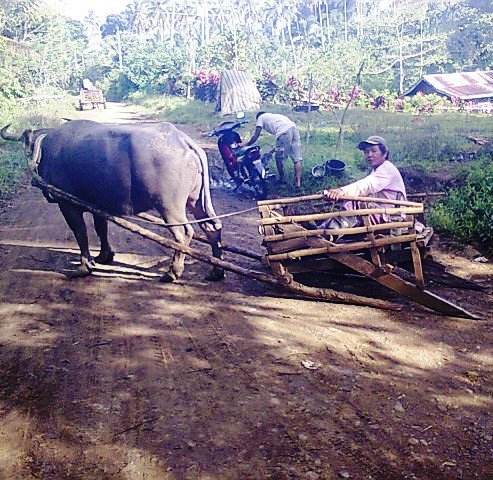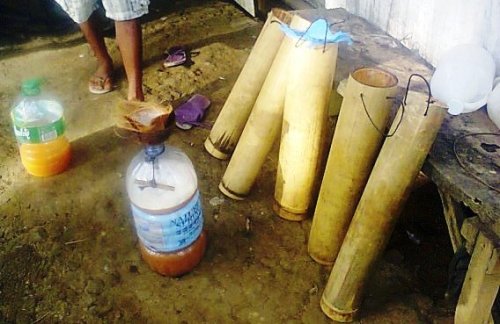So the next few weeks and months was to become a huge new learning curve. All I knew of Catigan was it was a little isolated, hilly and was told beautiful. It certainly was all those things but I didn’t really have much idea of what I was coming to. Every passing moment was a lesson especially in those early times. My first stay lasted 4 months.
The first couple of weeks were purely for psychological adjustment and trying to adapt to my new situation. I was okay with the ridiculously early nights. I was definitely okay with the peace and had no problem about having to walk far down bumpy and sometimes muddy slippery paths to get anywhere but I wasn’t okay with the lack of toilet facilities. Looking back now knowing how things unfolded, I can smile. At the time though, it was a big issue with me.
Fitting In
In the early days of my stay in Catigan, I went around meeting locals which was an enlightening experience. On my arrival, I sensed the usual mindset thinking of most Filipinos just about anywhere and I was asked all the usual questions pertaining to my perceived wealth. However, that was then. Over time, I got past that but the usual stereotyped thinking about foreigners and money became a too often mentioned topic. I was quizzed and I could sense them thinking, why is a man with money here trying to live like us.
It was known I was here to be with my sons and their mother, which made having to explain my purpose a little easier but the curiosity factor is always there. Filipinos want to know more than they need to know, something you get used to, I suppose.
However, foreigners have plenty of money, that’s always what people believe. So they want to know where my money comes from. If you don’t answer, then assumptions start. I have been in the Philippines long enough to know how to ride that one. I just have fun with their notions which always find their way back to you.
“Maybe he’s not saying much because he is a criminal.” It was mentioned once that I work online and a story spread that it was something illegal. I’m still trying to work that one out but I suppose a white guy staying so far off the tourist map and without a condo or hotel to go back to to take a crap was beyond their comprehension. It took a long time and that story will unfold but I did manage to make people aware I was not one of those foreigners although that was much later on.
Filipinos are no different from anyone else as regards curiosity and a need to know, but I would say that generally in the Philippines, they want to know more than most. I suspect this may be a topic matter to write on in the future but for now, let’s get back on track.
Welcomed
I soon began to get to know one or two of the people. On the whole I can honestly say that I was welcomed into the community and I was offered shots everywhere especially outside sari-sari stores where men were often drinking. They never failed to offer me a shot of mostly Tanduay (local cheap strong rum). For a chaser or mixer, some would use tuba which is what is also known as coconut wine. In those early days, I got very drunk on many occasions. I came to learn much about tuba but at this point, I was a total novice in rural living and had no idea what tuba was.
When I was given tuba as a chaser, I found it tasted sweet and didn’t even realize that it was alcoholic. I literally thought it was a sweet tasting soft drink. I would heartily drink it down after every shot of Tanduay and couldn’t understand why I was getting drunk so easily.
Coconut wine or tuba has a kick all of its own. Mix that with Tanduay, and bang! On more than one occasion, I had to be helped home as I was falling all over the place. The sweetness really had me fooled; I really did have a lot to learn.
Tribal Land
Catigan is Bagobo country. Now, I never learnt too much about Bagobo people from the Bagobo people themselves. In fact, I wasn’t even aware I was in the midst of people of the Bagobo tribe. I only found out when I asked my companion what some guys outside the sari-sari stores were talking about. She answered she doesn’t know as they are speaking in their native dialect. I asked the obvious question, “So what dialect are they speaking in?” Bagobo would be the reply. I had no idea.
I did learn over time that many were proud of their traditions and I did detect much talk of respect. If I was invited to drink and refused, It would be said “out of respect, have a drink with me” which made it very hard to say no.
I had to wait till I was back in the capital to research as the broken information I was given about Bagobo people only served to confuse me. I learnt that Bagobos are in quite a few corners of Davao and they are a fragmented tribe and cannot understand each other’s dialect. It took my own research to find out that the Bagobos of Catigan are the Bagobo Tagabawa tribe. The history of the Bagobo people is better explained by others. Learning a little about the history makes you realize just how rich and diverse Davao is.
I could not say to you I was witnessing what some romantics may think of as tribal life in the sense of how a westerner would picture it. Everything on the surface just appears to be as much the same as rural life all over Davao or at least from where I was looking at it.
Catigan is a mix of Bagobo Tagabawa people, Davaoeños (Dabawenyos, or name for people of Davao) and often mixed Tagabawa and Visayans. The culture of the Bagobo Tagabawa lives on through its beliefs, traditions and dialect, but it’s not obvious to an outsider like me.
They are a very hardy people as are many Filipinos from any part of the country. All of Davao is made up of a mixture of various tribal cultures and Visayan from the inhabitants who migrated here. The history is there to be explored and as many judge everything about the culture of the Philippines on what they observe from Metro Manila; it really is a good idea to learn a little about the overall history and culture of the locality and wider Philippines to understand a little more about where you are and understand its way of life. The more you know, the more you realize that nothing is quite what it seems. Much of the story is missing to the outsider therefore their perceptions are often based on misunderstanding and a little ignorance. History in the Philippines did not start only when the Spanish arrived.
Davao alone has an immensely rich history. To tell that story is not just a book but a whole series of books and if one city can have such history, imagine the rest of the country, too. We tend to think of the Philippines only in its modern day context as an ex-American colony and the ousting of President Ferdinand Marcos. Davao and the rest of the Philippines have many more stories to tell.
I will leave you to discover that for yourselves. For the purposes of this article, I shall simply relate it to my own limited experiences in Catigan. If you are ever in Davao, do visit the Museo Dabawenyo, it teaches you how little you do know.




